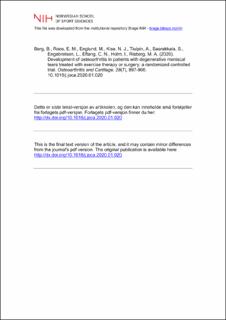| dc.contributor.author | Berg, Bjørnar | |
| dc.contributor.author | Roos, Ewa M. | |
| dc.contributor.author | Englund, Martin | |
| dc.contributor.author | Kise, Nina Jullum | |
| dc.contributor.author | Tiulpin, Aleksei | |
| dc.contributor.author | Saarakkala, Simo | |
| dc.contributor.author | Engebretsen, Lars | |
| dc.contributor.author | Engen, Cathrine Nørstad | |
| dc.contributor.author | Holm, Inger | |
| dc.contributor.author | Risberg, May Arna | |
| dc.date.accessioned | 2021-03-12T07:46:01Z | |
| dc.date.available | 2021-03-12T07:46:01Z | |
| dc.date.created | 2020-05-29T13:39:08Z | |
| dc.date.issued | 2020 | |
| dc.identifier.citation | Osteoarthritis and Cartilage. 2020, 28(7), 897-906. | en_US |
| dc.identifier.issn | 1063-4584 | |
| dc.identifier.uri | https://hdl.handle.net/11250/2733008 | |
| dc.description | I Brage finner du siste tekst-versjon av artikkelen, og den kan inneholde ubetydelige forskjeller fra forlagets pdf-versjon. Forlagets pdf-versjon finner du på sciencedirect.com / In Brage you'll find the final text version of the article, and it may contain insignificant differences from the journal's pdf version. The definitive version is available at sciencedirect.com | en_US |
| dc.description.abstract | Objective: To evaluate progression of individual radiographic features 5 years following exercise therapy or arthroscopic partial meniscectomy as treatment for degenerative meniscal tear. Design: Randomized controlled trial including 140 adults, aged 35–60 years, with a magnetic resonance image verified degenerative meniscal tear, and 96% without definite radiographic knee osteoarthritis. Participants were randomized to either 12-weeks of supervised exercise therapy or arthroscopic partial meniscectomy. The primary outcome was between-group difference in progression of tibiofemoral joint space narrowing and marginal osteophytes at 5 years, assessed semi-quantitatively by the OARSI atlas. Secondary outcomes included incidence of radiographic knee osteoarthritis and symptomatic knee osteoarthritis, medial tibiofemoral fixed joint space width (quantitatively assessed), and patient-reported outcome measures. Statistical analyses were performed using a full analysis set. Per protocol and as treated analysis were also performed. Results: The risk ratios (95% CI) for progression of semi-quantitatively assessed joint space narrowing and medial and lateral osteophytes for the surgery group were 0.89 (0.55–1.44), 1.15 (0.79–1.68) and 0.77 (0.42–1.42), respectively, compared to the exercise therapy group. In secondary outcomes (full-set analysis) no statistically significant between-group differences were found. Conclusion: The study was inconclusive with respect to potential differences in progression of individual radiographic features after surgical and non-surgical treatment for degenerative meniscal tear. Further, we found no strong evidence in support of differences in development of incident radiographic knee osteoarthritis or patient-reported outcomes between exercise therapy and arthroscopic partial meniscectomy. | en_US |
| dc.language.iso | eng | en_US |
| dc.subject | degenerative meniscal tears | en_US |
| dc.subject | knee arthroscopy | en_US |
| dc.subject | partial meniscectomy | en_US |
| dc.subject | exercise therapy | en_US |
| dc.subject | knee osteoarthritis | en_US |
| dc.subject | rehabilitation | en_US |
| dc.title | Development of osteoarthritis in patients with degenerative meniscal tears treated with exercise therapy or surgery: a randomized controlled trial | en_US |
| dc.type | Peer reviewed | en_US |
| dc.type | Journal article | en_US |
| dc.description.version | acceptedVersion | en_US |
| dc.source.pagenumber | 10 | en_US |
| dc.source.journal | Osteoarthritis and Cartilage | en_US |
| dc.identifier.doi | 10.1016/j.joca.2020.01.020 | |
| dc.identifier.cristin | 1813248 | |
| dc.description.localcode | Institutt for idrettsmedisinske fag / Department of Sports Medicine | en_US |
| cristin.ispublished | true | |
| cristin.fulltext | postprint | |
| cristin.qualitycode | 1 | |
